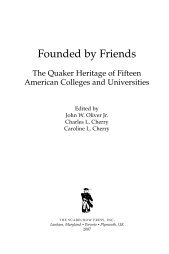Separate Realities: The Dream and the Iceberg - Scarecrow Press
Separate Realities: The Dream and the Iceberg - Scarecrow Press
Separate Realities: The Dream and the Iceberg - Scarecrow Press
Create successful ePaper yourself
Turn your PDF publications into a flip-book with our unique Google optimized e-Paper software.
84 Chapter 2<br />
BENEATH THE WATERLINE:<br />
CLASS MAINTENANCE AND LEGITIMATION<br />
To maintain <strong>the</strong>ir power <strong>and</strong> privilege, elites have learned to . . . exploit<br />
nonelites without <strong>the</strong>ir realizing <strong>the</strong>y are being exploited.<br />
—Harold R. Kerbo, Social Stratification <strong>and</strong> Inequality, 2006<br />
<strong>The</strong> second hidden dimension of <strong>the</strong> class iceberg involves <strong>the</strong> structures<br />
<strong>and</strong> processes that maintain <strong>and</strong> legitimate <strong>the</strong> new class society. Of course,<br />
elite classes in stratified societies have always devoted a portion of <strong>the</strong>ir considerable<br />
resources to legitimating <strong>and</strong> reinforcing <strong>the</strong> class system, <strong>the</strong>reby ensuring<br />
<strong>the</strong>ir continued possession of disproportionate levels of wealth, power,<br />
<strong>and</strong> privilege. However, <strong>the</strong> problems of maintaining <strong>and</strong> legitimating <strong>the</strong><br />
emerging new class society have been rendered more complex by <strong>the</strong> extreme<br />
inequalities of <strong>the</strong> system <strong>and</strong> <strong>the</strong> tension between <strong>the</strong>se class realities <strong>and</strong> <strong>the</strong><br />
relentless, media-driven promotion of <strong>the</strong> American <strong>Dream</strong> as a cultural ideal<br />
(see <strong>the</strong> box at <strong>the</strong> end of this chapter, “Class Issues in <strong>the</strong> Media: <strong>The</strong> American<br />
<strong>Dream</strong>”). Thus, <strong>the</strong> current class-maintenance <strong>and</strong> -legitimation strategies,<br />
structures, <strong>and</strong> policies combine sophisticated extensions of approaches used<br />
in <strong>the</strong> past with emerging, innovative forms of control <strong>and</strong> distraction.<br />
<strong>The</strong> Class-Power-Network Model<br />
Our perspective on how <strong>the</strong> new class system is maintained <strong>and</strong> legitimated<br />
is based on an organizational model of class interests <strong>and</strong> power. It views large<br />
firms as repositories of superclass resources <strong>and</strong> also as dominant sources of<br />
power in virtually all sectors of society. According to this approach, privilegedclass<br />
leaders use corporate-based resources to create, fund, <strong>and</strong> control extensive,<br />
overlapping organizational networks within <strong>the</strong> economic, political, <strong>and</strong><br />
cultural social arenas. <strong>The</strong>se networks consist of organizations linked by various<br />
connections, such as interlocked board members, shared public policy interests,<br />
<strong>and</strong> common goals, including <strong>the</strong> maintenance <strong>and</strong> legitimation of<br />
concentrated privileged-class power <strong>and</strong> wealth.<br />
In <strong>the</strong> economic arena, network examples include superclass-controlled<br />
trade associations <strong>and</strong> peak corporate groups, such as <strong>the</strong> Business Roundtable.<br />
Superclass-funded public policy “think tanks,” lobbying organizations,<br />
<strong>and</strong> PACs are examples of organizational networks within <strong>the</strong> political arena.<br />
In <strong>the</strong> cultural arena, network examples include superclass-funded foundations,<br />
civic <strong>and</strong> cultural organizations, <strong>and</strong> elite university boards of trustees.<br />
We view <strong>the</strong>se interlocked organizational networks as directed by privilegedclass<br />
leaders who use <strong>the</strong>m to pursue strategies <strong>and</strong> objectives that reinforce<br />
<strong>the</strong> shared economic, political, <strong>and</strong> cultural interests of <strong>the</strong>ir class. <strong>The</strong>se include<br />
legitimating corporate autonomy, power, <strong>and</strong> profit maximization, as<br />
well as maintaining <strong>the</strong> organizational structure of <strong>the</strong> new class system so as
















